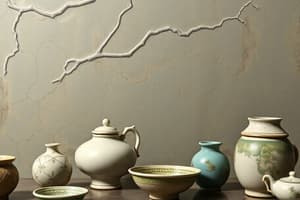Podcast
Questions and Answers
Flashcards are hidden until you start studying
Study Notes
Applications and Processing of Ceramics
-
Ceramics are compounds between metallic and nonmetallic elements with ionic or predominantly ionic inter-atomic bonds.
-
Ceramics exhibit physical properties that differ from those of metallic materials and complement them in service.
-
Ceramics are classified as traditional ceramics (made from clay, silica, and feldspar) or engineering ceramics (made from highly pure compounds of Al2O3, SiC, and Si3N4).
-
Glasses are a familiar group of ceramics containing non-crystalline silicates with specific responses to heating.
-
Clay products include structural products (bricks, tiles, sewer pipes) and white-wares (porcelain, chinaware, pottery, etc.).
-
Refractories are ceramics that withstand high temperatures and severe environments without melting or decomposing.
-
Abrasive ceramics are used to grind, wear, or cut away other materials and require hardness, wear resistance, and refractoriness.
-
Advanced ceramics have newly developed electrical, magnetic, and optical properties for specific applications.
-
Ceramic powders are processed through milling/grinding, shaping, and consolidation (sintering or firing) to obtain the final product.
-
Ceramic powder shaping techniques include compaction, tape casting, slip casting, injection molding, extrusion/hydro-plastic forming.
-
Ceramic powder sintering is the firing process applied to green ceramics to increase its strength and densify it.
-
Ceramics are known for their corrosion resistance due to their chemical inertness in corrosive environments.Challenges in Using Ceramics as Corrosion Resistant Structural Materials
-
Ceramics are prone to chemical dissolution rather than electrochemical corrosion.
-
Ceramics can degrade rapidly in certain environments.
-
There is a need for reliable and corrosion-resistant structural ceramic materials.
-
Beta-alumina is being investigated for high energy battery systems.
-
SiC and composites are being investigated for use in heat exchangers.
-
Ceramics are more environmentally stable than metals or plastics.
-
The potential for ceramics as corrosion-resistant structural materials is not fully realized.
-
One challenge is the mechanical non-reliability of structural ceramic components.
-
Ceramic components can be brittle and prone to fracture.
-
Ceramic composites can offer improved mechanical properties.
-
Research is ongoing to develop more reliable and durable ceramic materials.
-
Overcoming these challenges could lead to expanded use of ceramics in aggressive environments.
Applications and Processing of Ceramics
-
Ceramics are compounds between metallic and nonmetallic elements with ionic or predominantly ionic inter-atomic bonds.
-
Ceramics exhibit physical properties that differ from those of metallic materials and complement them in service.
-
Ceramics are classified as traditional ceramics (made from clay, silica, and feldspar) or engineering ceramics (made from highly pure compounds of Al2O3, SiC, and Si3N4).
-
Glasses are a familiar group of ceramics containing non-crystalline silicates with specific responses to heating.
-
Clay products include structural products (bricks, tiles, sewer pipes) and white-wares (porcelain, chinaware, pottery, etc.).
-
Refractories are ceramics that withstand high temperatures and severe environments without melting or decomposing.
-
Abrasive ceramics are used to grind, wear, or cut away other materials and require hardness, wear resistance, and refractoriness.
-
Advanced ceramics have newly developed electrical, magnetic, and optical properties for specific applications.
-
Ceramic powders are processed through milling/grinding, shaping, and consolidation (sintering or firing) to obtain the final product.
-
Ceramic powder shaping techniques include compaction, tape casting, slip casting, injection molding, extrusion/hydro-plastic forming.
-
Ceramic powder sintering is the firing process applied to green ceramics to increase its strength and densify it.
-
Ceramics are known for their corrosion resistance due to their chemical inertness in corrosive environments.Challenges in Using Ceramics as Corrosion Resistant Structural Materials
-
Ceramics are prone to chemical dissolution rather than electrochemical corrosion.
-
Ceramics can degrade rapidly in certain environments.
-
There is a need for reliable and corrosion-resistant structural ceramic materials.
-
Beta-alumina is being investigated for high energy battery systems.
-
SiC and composites are being investigated for use in heat exchangers.
-
Ceramics are more environmentally stable than metals or plastics.
-
The potential for ceramics as corrosion-resistant structural materials is not fully realized.
-
One challenge is the mechanical non-reliability of structural ceramic components.
-
Ceramic components can be brittle and prone to fracture.
-
Ceramic composites can offer improved mechanical properties.
-
Research is ongoing to develop more reliable and durable ceramic materials.
-
Overcoming these challenges could lead to expanded use of ceramics in aggressive environments.
Studying That Suits You
Use AI to generate personalized quizzes and flashcards to suit your learning preferences.




